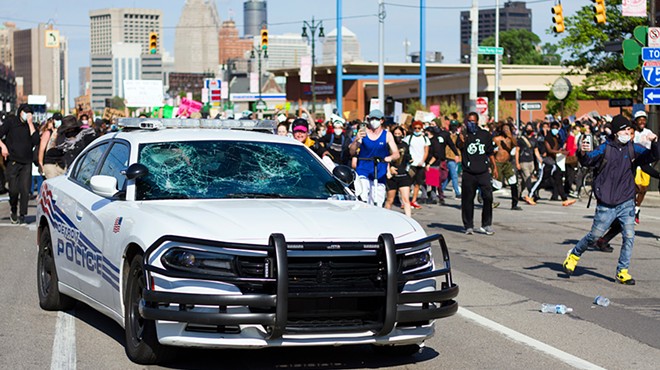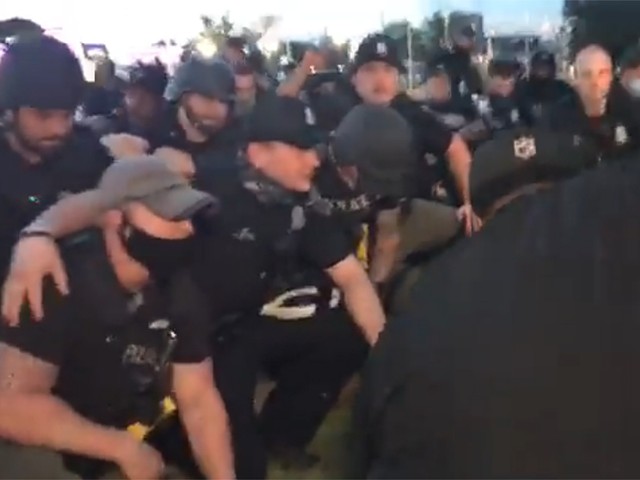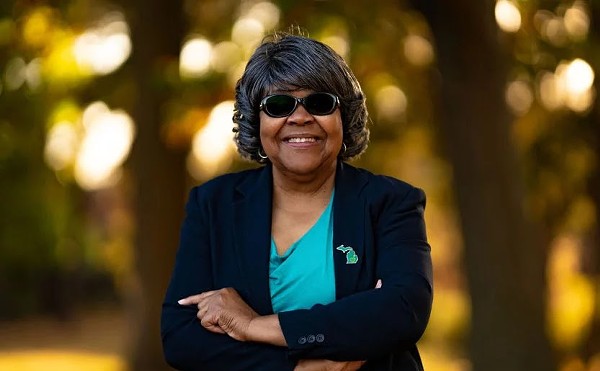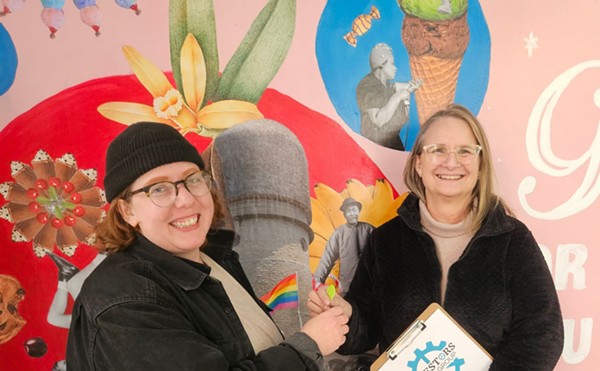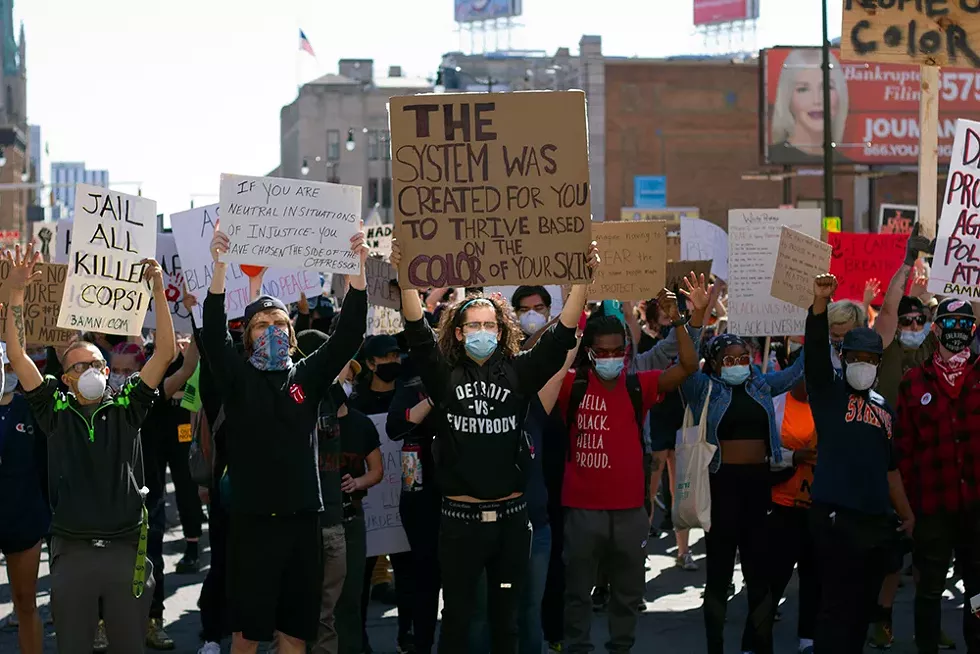
Friday evening was supposed to be a time of unity in Detroit.
To boost morale two and a half months into the coronavirus pandemic and remind people of the importance of filling out the census, the City of Detroit put on an “Everybody vs. COVID-19” livestream music festival featuring some of the biggest local hip-hop artists. During a taped segment, Gov. Gretchen Whitmer even donned a coveted pair of Cartier “Buffs” sunglasses, a distinctly Detroit status symbol, while introducing rapper Gmac Cash — the culmination of a weeks-long social media gag rooted in community support. In April, as armed right-wing protesters began showing up in Lansing in opposition to Whitmer’s stay-at-home order, Black Twitter came to the defense of the governor, dubbing her “Big Gretch” and praising her for her strong leadership in keeping the coronavirus at bay, which has ravaged Detroit particularly hard. At some point someone Photoshopped a pair of Buffs on a picture of Whitmer, which Cash used as the artwork for his viral track of the same name. A meme was coming to life.
“I’m looking forward to accepting the many cookout invitations that were sent my way. But until then,” Whitmer said, dramatically pausing as she donned the Buffs, “stay home, stay smart, and stay safe.”
The moment was clearly meant to be a showstopper, and in better times, it certainly would have been. But just as it was happening, civil unrest was boiling over in Detroit as police clashed with protesters.
Earlier that week, on Memorial Day, Minneapolis policeman Derek Chauvin killed 46-year-old George Floyd after pinning him down to the ground and kneeling on his neck for nearly nine minutes, all for the crime of allegedly using a counterfeit $20 bill at a deli. The incident was caught on video and swiftly circulated around the internet, calling to mind the 2014 death of Eric Garner in New York City, who was tackled to the ground by police and put in a chokehold for allegedly selling unlicensed cigarettes. Garner’s last words uttered became a rallying cry to the Black Lives Matter movement: “I can’t breathe.” The exact phrase was echoed by Floyd as onlookers pleaded for Chauvin to stop.
As protests started in Minneapolis, in Detroit, Police Chief James Craig attempted to get ahead of the situation. In a press conference on Thursday afternoon, he said he supported the Minneapolis Police Department’s firing of the four officers involved in Floyd’s killing, which he called a “murder.” Beyond that, he said that based on the video evidence, he believed Chauvin should be arrested — becoming the first major-city police chief to do so.
Craig pointed out that his own department has disciplined its own officers in the past, citing several examples — including one as recently as March of this year, when an off-duty cop pulled a gun during a dispute at a party. He also said he issued a memo to the department reiterating its use-of-force policy, which prohibits neck restraints, and also emphasized the importance of de-escalation in altercations.
“Based on my 44 years of experience, I can tell you that when even one officer engages in excessive force, we all share the disappointment for the dishonor it brings to our badge,” he said. “Those of us in law enforcement take a solemn oath to protect and serve with courage, integrity, and respect. And that’s what the community expects.”
On Wednesday, as officials deliberated charging Chauvin, protesters looted a Target store near Minneapolis’s Third police precinct — a symbolic act, as the company is headquartered in the city. On Thursday evening, they burned down the precinct while fireworks burst in the sky — providing an incredibly on-the-nose answer to the question posed by Detroit’s famous summer of civil unrest in 1967: “riot or rebellion?” Tensions were further stoked when President Donald Trump tweeted “when the looting starts, the shooting starts,” which Twitter flagged for violating its rules prohibiting inciting violence.
On Friday morning, Chauvin was arrested and charged with third-degree murder and manslaughter. That afternoon, a Black Lives Matter rally was held outside Detroit’s Public Safety Headquarters.
Things started off peacefully, with DPD officers handing out face masks and hand sanitizer to the participants. As the rally turned into a march, police even served as an escort. Officials said they estimated the rally drew a crowd of some 1,500 protesters, who were largely peaceful.
Given the circumstances, it’s not surprising that this Black Lives Matter protest took off in a way that no other has. People have been cooped up in quarantine for weeks, isolated from each other. Millions of people are unemployed with no sign of when their next paycheck is coming. Many likely decided to brave the risk of exposure to the virus simply because they have nothing left to lose.
As the march headed into Corktown, something changed in the crowd, with protesters starting to throw bottles and rocks at police. At one point, someone smashed a police car’s windows. Initially, police officers retreated from the attacks. But when the march returned to the police headquarters, they were met with a line of officers clad in black riot gear. As night fell, the clashes continued, with police deploying tear gas into the crowd. Amid the melée, a 21-year-old man was shot and killed, though it’s not yet clear whether it was connected to the protests.
Speaking to reporters on Friday night, Craig, who recently recovered from COVID-19 as one of the city’s first high-profile people to come down with the virus, questioned why people would even risk transmitting it by protesting in Detroit — where the illness has killed more than 1,300 and forced 600 DPD officers into quarantine in March.
“If you really believe Black Lives Matter, we’re still battling COVID,” he said. “I’m a COVID survivor. African-Americans are two to three times more likely to either get COVID or die from COVID. So do us a favor: If you live outside the city, why don’t you protest in your hometown? If you do want to come down and make a statement, do it in a peaceful way.”
On Saturday, Mayor Mike Duggan called a press conference with Craig and several Black community leaders and activists to denounce the violence and call for peace. Using a line that was repeated by officials in municipalities across the country, they blamed “outside agitators” for infiltrating the peaceful protests and escalating the conflict. In Detroit’s case, that meant white people from the surrounding suburbs.
Indeed, photos and video from the protests showed a diverse crowd, not reflective of Detroit’s majority-Black demographics. Of course, that could just be testament to the continued rise and mainstreaming of the Black Lives Matter movement. In 2016, NFL quarterback Colin Kaepernick started kneeling during the national anthem to protest police brutality — bringing more exposure to the cause, but getting him blackballed from the league. Shortly after, America elected Trump, who turned what was once a dog-whistle for racism in the GOP into a blaring bullhorn.
The claim that the nationwide protests were being escalated by white — possibly even alt-right — provocateurs got traction early on when a viral video out of Minneapolis showed a man wearing a gas mask and carrying an umbrella stoically smashing the windows of an Auto Zone with a hammer. When an onlooker asks “Are you a fucking cop?” he sheepishly darts away. The conspiracy theory was further boosted when Melvin Carter, the Black mayor of Saint Paul, initially said “every person” arrested in Minneapolis’s protests was from out of state. He later walked back the claim after a report found nearly all the people arrested actually lived in Minneapolis or the surrounding area, saying he received faulty information. (The “outside agitators” trope is not new, dating back to the time of Martin Luther King Jr.)
Still, it wasn’t exactly far-fetched. “Maybe all of these people come from cities whose police departments are not in need of their voices and they felt they had to come down here,” Duggan said. “Or more likely they came here to damage property and to throw rocks and bottles at our police officers.”
Pastor Maurice Hardwick said he believed people should protest in the suburban communities, not in Detroit, where Black drivers are pulled over by police more frequently. “You have the right idea, just the wrong city,” he said. (In fact, smaller protests were held in suburbs like Livonia, Royal Oak, and Westland.)
Community leader Ray Winans said he believed the arrests showed a double standard. “If any of our Black and brown boys from Detroit would’ve went to any of those suburbs and thrown bricks and rocks, I’m pretty sure we’d be a CNN world news story, because they probably would have been murdered,” he said. “We don’t need no outsiders coming in, disrupting our communities trying to tear up our stuff, because we can’t do that in West Bloomfield.”
Rev. Charles Williams II, president of the National Action Network, was even more blunt. “These outsiders put our community in harm’s way,” he said. “And I use the term ‘outsiders’ nicely. But really what I would like to say is that they’re no different than what we consider white supremacists.”
Rev. Wendell Anthony, head of the local branch of the NAACP, said that he understood why well-meaning outsiders would choose to march in Detroit, however. “In a moment like this, people are angry, they’re upset, they are sending out on social media ‘show up in the D’ because showing up in the D is sexy,” he said. “If you say show up in Livonia, that ain’t sexy. If you say show up in Troy, show up in Grosse Pointe, that ain’t sexy, because the national media would rather come to Detroit ... rather than to go to Livonia, or these other places, but that's where the action needs to be.”
Hardwick said he believes newcomers and outsiders should check in with local longtime activists and follow their lead. Anthony recommended activist organizers designate “marshals” to self-police the groups to make sure everyone is supporting the goals of the protest. “Don’t agonize, organize,” he said. “I know America was built on protest ... but there’s a way in which we can do that, and that’s all we’re saying.”
All of the activists, some of whom said they met Craig while protesting police as activists, said that they believed he was doing a good job. “We fought for this,” Anthony said, pointing at Craig. “We fought for a Chief Craig. We fought for a police community commission. We fought for Black folk to be in the department.”Given the circumstances, it’s not surprising that this Black Lives Matter protest took off in a way that no other has. Many likely decided to brave the risk of exposure to the virus simply because they have nothing left to lose.
tweet this
To be sure, the Detroit Police Department has its own rap sheet. It was conflicts with DPD that sparked the infamous summer of unrest in 1967, then the nation’s bloodiest civil disturbance since the Civil War, resulting in 43 dead, 1,189 injured, and more than 7,200 arrests. In the aftermath, the department created the secret STRESS force that further stoked tensions, conducting hundreds of raids without search warrants and prompting thousands to march to demand its abolition. In 1992, DPD officers killed Malice Green in a high-profile case of police brutality, and a decade ago, a DPD officer accidentally killed 7-year old Aiyana Stanley-Jones during a raid that was being filmed for a reality-TV show. But since being appointed as Detroit’s police chief under the city’s emergency management in 2013, Craig’s biggest controversies have been saying he believed putting more guns in the hands of Detroiters would lower crime, his department escorting a small group of neo-Nazis during Motor City Pride in 2019, and the implementation of the Project Green Light surveillance network, which some feared could lead to “a 1984, George Orwell-type of scenario.”
When asked why the department would not stand down, Craig said he did not want Detroit’s police headquarters to be destroyed as Minneapolis’s Third Precinct was. He also said after Friday’s protest that the department had a debriefing on its own actions, and believed it used an appropriate amount of force. “We paid very close attention to how we responded yesterday,” he said. “We are making some adjustments ... but I feel very good about this evening.”
But Saturday night, protesters and police clashed again. Once again, a demonstration that started peaceful turned violent at night, with more cops in riot gear and more tear gas. One video on Twitter showed an officer screaming at a protester to keep moving, and another officer running into the frame and shoving the protester to the ground. (All three men appeared to be white. A city official confirmed to Metro Times that the department is investigating the conduct of the two officers.) Incidents like those were spotted at protests across the country, prompting a searing Slate headline, “Police Erupt in Violence Nationwide” — only further demonstrating, in the eyes of the protesters, the need for the protests.
In a Sunday press conference, Craig said the number of arrests made on Saturday grew to 84. He continued to maintain that the majority of those arrested were people with out-of-town IDs; one came from Ohio, and another came from Tennessee. Craig said the department had enlisted the help of Homeland Security and the FBI, and said that they have found evidence that suggests the protests were highly organized, citing walkie-talkie communication and vehicles that were dropping off supplies, though when questioned by a reporter, he declined to discuss the matter further, citing the ongoing investigation.
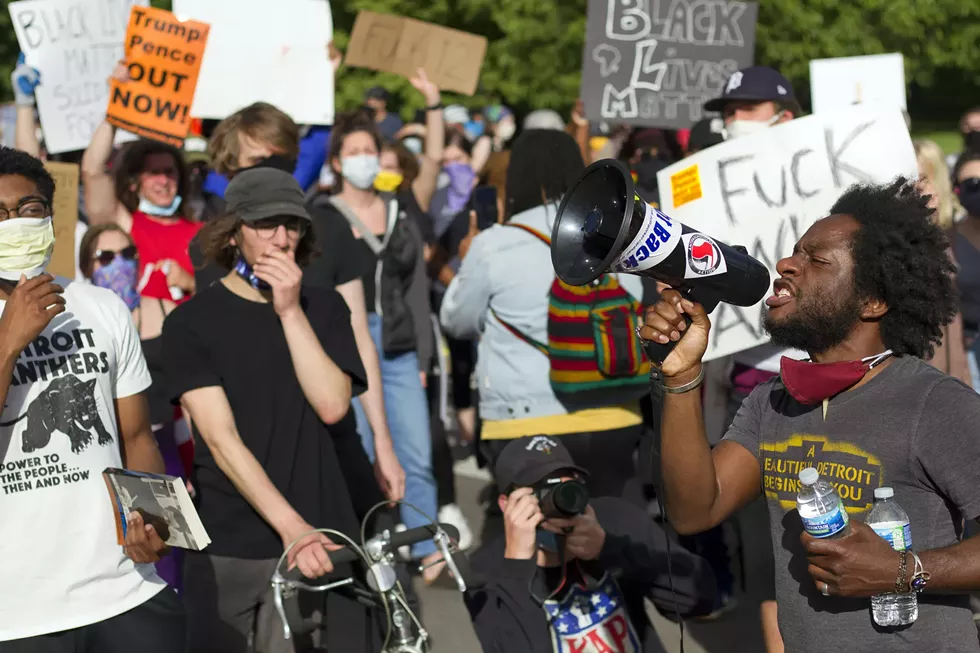
“You know what, what is funny about that is that describes the Detroit police department,” he says. “Those white people who are outside of the city, who don’t live in the city, who come in and sit in and terrorize the people? Yeah. They’re the real agitators.” (During Sunday’s press conference, a reporter asked what percentage of DPD’s officers were Detroit residents. Craig said he couldn’t say off the top of his head, but noted that DPD does not require its officers to live in the community; he estimated it was only about 35-40 % of the force. As of last year, the department reported its demographics were 56.3% Black, 37.4% white, 5.1% Hispanic, and 1.2% classified as “other.”)
When asked if he felt the peaceful protests were hijacked by people with a different agenda, Taylor disagrees that the goal was ever peace in the first place.
“I don’t put ‘peace’ on a pedestal,” he says. “I think the question of peace has to be put in its proper context. This series of protests that have happened is in response to peace being broken on behalf of people whose job it is supposedly to uphold and maintain peace.”
Throughout the nights of protests, Taylor says he believes it was DPD that initiated the aggression, even if it was in subtle ways. “This quote-unquote ‘peaceful protest’ is greeted by police in riot gear when we get back to the police station,” he says. On Saturday night, he says he saw one of the officers wearing riot gear acting “like a fucking gorilla, smashing his helmet and shields, ready for action,” and says he saw numerous instances of the officers verbally taunting the protesters, including himself.
Of the violence, “I think people’s rage and anger is legitimate,” he says. “That police station that went up in flames in Minneapolis, right? It’s the reason why that cop is in jail and charged with murder. And if it takes 10 more police stations across this country and a thousand more Targets to have to burn to the ground for Black bodies to matter and for justice to happen, let it happen.”
He adds, “We didn’t set those terms — the violence of the police and the state and doing harm to Black and brown bodies and to the working class is what set those terms.”
As for the white, out-of-town protesters, Taylor says he welcomes them to the movement.
“We say this is America’s problem, right?” he says. “If this is America’s problem, it’s actually the obligation and duty of America to stand with Black and brown bodies.”
When asked how long he thinks the protests will go on for, Taylor says he’s not sure.
“The movement will decide,” he says. “And so far, this movement is determined to move.”
On Sunday, another protest was called, prompting Duggan to set an 8 p.m. curfew. As the curfew approached, protesters formed a line, demanding the approaching DPD officers join them in kneeling, a symbolic nod to Kaepernick.
“For tactical purposes, my men cannot kneel,” Deputy Chief Todd Bettison said on a megaphone. “But I will on behalf of them. I will show you that we are with you. I will kneel.”
It was a moving gesture. But shortly after, the tear gas was once again deployed on the crowd, as well as rubber bullets and flash grenades. On Sunday evening, DPD made more than 100 arrests, the majority of them from metro Detroit, according to a department spokeswoman.
Elsewhere in Michigan, protesters lit cars on fire in Grand Rapids and smashed the windows of the Governor’s office in Lansing, causing their mayors to request the National Guard. Similar situations played out in more than 140 cities throughout the United States.
Steve Neavling contributed to this report.
Stay on top of Detroit news and views. Sign up for our weekly issue newsletter delivered each Wednesday.



